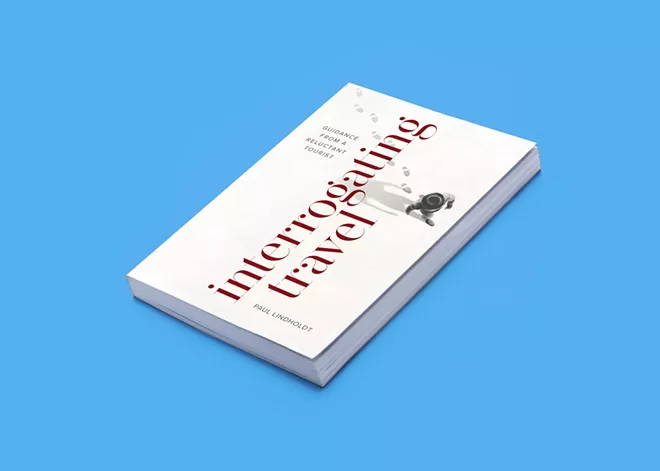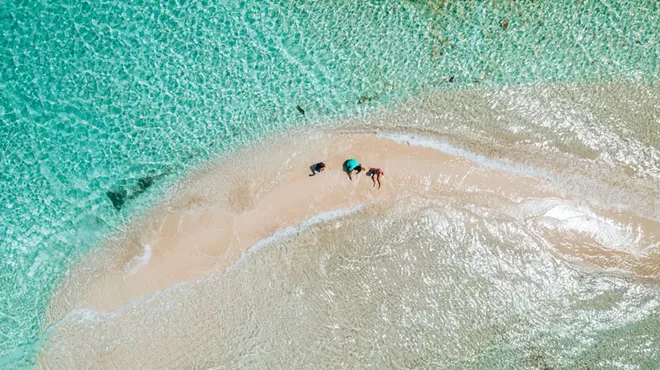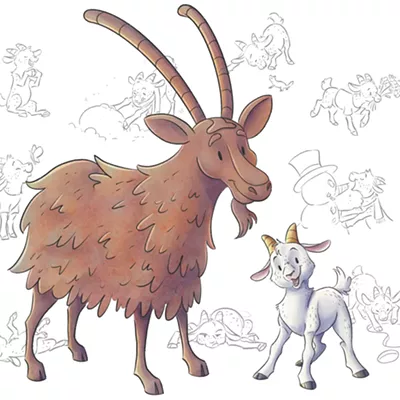At the Kailua-Kona Harbor we gather with two dozen others on the 60-foot Fair Wind, a catamaran with a crew of eight. That fast ship will transport us to Kealakekua Bay. Advertised as an homage to Captain Cook, near whose monument we anchor, the trip turns out to be a feeding and snorkeling frenzy. Moving parts of that craze, we line up right behind the others.
When we arrive in the bay where the explorer died, igneous cliffs plunge to underwater canyons. Invisible lava tubes corrugate the cliffs. Islanders buried their chiefs in those tubes, we learn from a shipboard brochure. The Fair Wind drops anchor. Snorkels and masks are handed around.
The monument itself to Captain Cook, a 27-foot obelisk of marble, looks like a missile blasting off. Its shape and size seem so right. Its color is white, its configuration the same sort shared by hardware for military aggression and for space exploration alike. Forbidden from going ashore, we have a view of the vaulting monument from 75 yards out.
One shipside brochure tells its story and reprints a photo of the bronze plaque dedicating the stone: "In memory of the great circumnavigator, Captain James Cook, R.N., who discovered these islands." Discovered? I read that assertion and I flinch. Such language generates rifts today between the colonizers and the colonized, between those who immigrate to the Hawai'ian islands or tour them, and those whose ancestors have inhabited them for ages.
I toss aside the brochure, take up snorkel, put on a mask, and plunge. Forests of pastel coral fall to sandy canyons undersea. Breathless and exhilarated, I spot legendary moray eels. One, white and black-spotted, flexes its formidable jaws from a grotto, until a swimmer jabs at it with his fin. Another eel, a 4-foot yellowmargin moray — thick, brawny, gold-flecked brown — snakes along the bottom, still-hunting undercover before slipping across an expanse of sand to nose into the next floret of coral. Indigenous people call this species puhi-paka and eat it. In the cliffs above us, like balls in cannon barrels, the royals lie mummified inside lava crypts.
Back on the boat after swimming, we lunchtime passengers brazen our way to the foods, many of us wearing undersize swimwear. One in front of me, with a little boy, packs her plate and explains how hard it is to have to load up for two. Several of the passengers, already seasick despite the stopgap capsules the crew hands out, cling to the railings or collapse on the stairs.
Arousing us from our after-lunch slump, a deck mate cries, gestures, and points.
A woman has clambered up on the monument to Captain Cook! Dressed in shorts and T-shirt, she leans against the obelisk, hands clasped behind her, as if manacled. We've been asked to stay in the water to save the reefs, ordered to avoid the sacred monument to Captain Cook. The deck mate, never noticing that the woman is dry, assumes she swam from the boat. But she's in fact an islander, a twenty-something local, solid, squat, her hair falling to her waist, her thighs and belly strong. She has hiked alone down from the road above the memorial site.
An Indigenous woman, she has watched the ship disgorge us tourists, as she has no doubt seen it do before. She has stood in silence at the base of the white stone. But now the mate is hollering at her, playing the heavy, ordering her off the monument and back to the ship where she should be. Her hands fly up like wings, manacles shed, as if to levitate her from the shore.
We have come to this sacred spot, a neon brigade in suits and swim masks, to be fed and swim and have a fine time. The Fair Wind has anchored at the spot the brochure names the Pathway to the Gods. But the rule-ridden shipboard lecture tells us nothing about the gods, loaded like cartridges in the cliffs above us, dormant or alive. Our barbecues are smoking, our 15-foot waterslide and high-dive platform splashing. Four stout poles, on the swift trip out, have trolled for billfish and tuna off the stern. What a sight we must be to residents like her.
Belatedly the mate realizes the woman is Indigenous. Explosive anger lights her face. She is wading into the surf now, stroking for our boat, pointing toward us every few yards. Off the starboard railing she stops and treads the water, unloading her words like so much weaponry. "You have no right to be here! You are ruining this spot! Why don't you go away and stay?"
We have committed kapu, defiled the living lands, the people, and the seas. She might still be smarting from the overthrow of the Hawaiian monarchy by U.S.-backed forces in 1893. Five years later, the United States annexed Hawai'i. The kingdom of Hawai'i became a U.S. territory, absent any input from the people and amid much opposition. Attempts to restore the kingdom have always failed. Too much mainland money is tied up here. In July 2021, the late Microsoft cofounder Paul Allen's sprawling, 22-acre Hawai'ian property sold for $43 million.
This comely, muscular young woman begins to blur for me. She becomes one with the encrypted royals and the people who Cook colonized. "Our unfortunate commander," one of Cook's crew wrote, "the last time he was seen distinctly, was standing at the water's edge, calling out to the boats to cease firing, and to pull in." Our Indigenous hostess, the last time we see her, is rising by the white marble monument, trembling with fury, her long black hair slinging spray.
The "spectacular marine environment" that our brochure touts is "like swimming in an aquarium," is squandered upon us. We have swarmed the coral in this "tranquil, secluded cove." We have listened to the captain's eloquence about "protecting and respecting" the environment. We have imagined we are heightening awareness, raising a collective ecological consciousness. We have yet to understand the profound relationships between the local people and ecology.
Environmental education requires certain sacrifice zones, some pundits claim, places where ecological integrity must be relinquished for the sake of edification. The planet will begin to heal, they say, if people can absorb enough information and enjoy apt opportunities to bond. The same philosophy might hold sway within the tourist industry — that some locals need to be sacrificed for the betterment of cultural sensitivity and to build relationships on a larger scale.
If we infuriate the locals, when we practice slapdash environmental edification on their turf, we will have failed. Maybe Hawai'ian commerce instead ought to be propitiating the gods and risk affronting the tourists, like a certain healer at Lapakahi State Historical Park did for me.
Lapakahi lies on the Kohala coast, north of Kona and Kealakekua Bay. A partially restored pre-contact fishing village, its bits of old dwellings lie visible on the oceanside. We are fortunate to find it open, blessed to visit in the absence of commercial trappings so often found elsewhere.
Bart spurs up to the door carrying his hi-vis lime mesh sport bag. "No towels allowed," the woman keeper tells him. We stiffen before her office-cum-museum and clinic. Bart trots his gear back to the car, too sobered to ask why. Visiting hotel guests have littered, we can surmise.
"This is a holy place," she begins. "You enter the water here," pointing to a spot on a mural-sized aerial photograph. "Don't swim to the right or left. Go straight out only." We meet her steely gaze. We turn around and follow her kinked finger pointing to an alley out from shore.
That alley, steep and boulder-strewn, looks daunting. "To the left are sacred spaces where our ancestors lived and bathed. To the right, we've had too many people hurt when they got tossed up on the rocks." The cove looks like a graveyard, and she speaks like its guardian shade.
Her ancestors inhabited this place for more than 600 years, she informs us. Foundations of their buildings crumble. Rows of low rocks, grass-roofed huts reconstructed in some spots. The site has now become a rustic park of some 300 acres. She references the walls, plants, wind, and surf as the "lives accompanying you." She never gives her name.
Stern curator, she is riding herd upon us like any paniolo, enforcing rules, contending for reverence. "Don't make me follow you down there to keep you on the trails," she warns. Her job entails the tricky task of breaking tourists of being boors. We are her only guests in the entire park just now. Several hundred yards offshore, the humpback whales are spouting and sounding.
Before she will let me swim, she grabs my hand and focuses on it. She noticed a wound she wants to treat, to show me how her healing may take place. Above my cradled and upturned palm, her downturned hand caresses the air. I had sliced the palm on a piece of coral when a wave flung me in shallow surf. "It's best to do it when the wound is new," she explains.
Now she has my full attention. Squat, gray, creased, and kind, she wears a ribbed tank-top above, a pair of baggy surfer shorts below, bone-print on the fabric. This docent is a welcome contrast to the starched and badged keepers we see in the 48 mainland states. Releasing me, she follows us partway down the sea-path, still lecturing, still contending for our reverence. ♦
Excerpted from Interrogating Travel: Guidance from a Reluctant Tourist. Reprinted by permission of LSU Press.

















